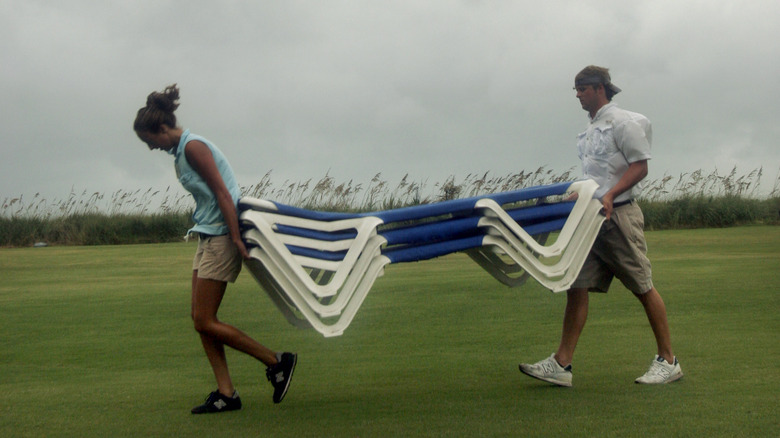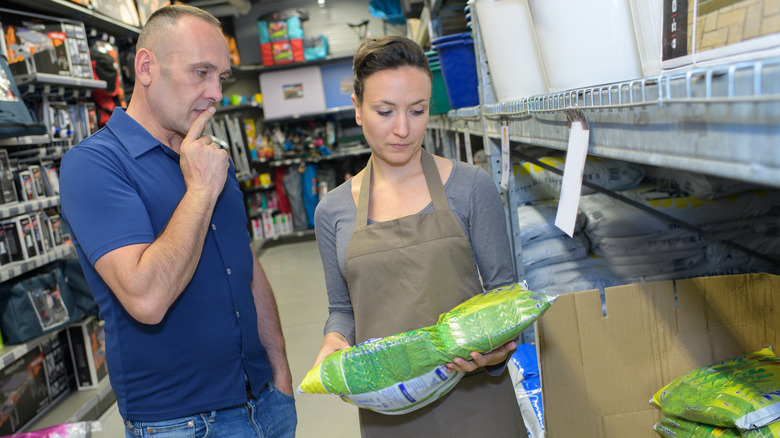The Genius Way To Keep Your Outdoor Patio Furniture Secure
We may receive a commission on purchases made from links.
Have you been hunting for a brilliant hack to keep your outdoor cushions in place on a windy day? Sure, you could chain your table and chairs to a patio pole when they're not in use, but that looks tacky and is a pain to unchain whenever you want to relax in your yard. Bolting the furniture to the ground is possible — unless you're renting or don't want to destroy those beautiful slate pavers you paid so much to lay. Instead, you need reusable, removable sandbags, either storebought (think the ones you'd use to keep flood waters from infiltrating a building) or homemade, placed on or inside your outdoor furniture and soft furnishings.
Obviously, hefty solid wood or concrete outdoor furniture isn't going to move much, even on stormy days. But not all of us want or can afford such high-end sets. Plastic, rattan, light wood, or even metal pieces are easily shifted by moderate wind speeds — 28 miles per hour wind will move a trash can, whereas 67 miles per hour wind can move a person. While the particles in sand are teeny tiny, they're made of naturally heavy stuff. Builders' sand, for example, might include crystalline silica, crushed rock, coral, assorted minerals, and shells. The average sandbag weighs 10 to 15 pounds. Plus, the sand is squishy. It molds around things, and comfort isn't compromised if you put it inside a cushion.
Keep the big pieces in place
Sandbags (also called furniture weights) either securely sit on or wrap around the legs of patio furniture. Walmart sells purpose-made circular weights — one for $29.99 — that you fill with sand and affix snuggly around furniture legs or umbrella poles. If you don't mind something decidedly more utilitarian, you can get a 25-pack of DuraSack 50-pound capacity woven polypropylene sandbags for $13.28 at Lowe's. You could also make your own. Grab any old big piece of fabric (bonus points if waterproof), a thick trash bag, and a sewing machine or needle and thread. Cut the trash bag and fabric to the same size and sew the liner (the trash bag) to the fabric. Then, sew the newly lined fabric as you would a pillowcase, leaving it open on the end. Fill the resulting bag with sand — All American Play Sand, $6.95 for a 50-pound bag at Ace Hardware, is affordable and works well — and stitch it closed.
Finding it hard to get your hands on the right sand? Alternatives include clay cat litter (just make sure whatever it's in is totally waterproof, or you'll have an immovable lump of clay on your hands), rice or other grains, smooth pebbles, and or even water in a waterproof container à la those round, liquid-filled umbrella stands you see on restaurant patios. Or, if you're really handy, you could turn an IKEA plastic chair into elegant outdoor furniture with this genius cement hack. Cement is arguably sand-adjacent, after all!
Secure your soft furnishings
The soft furnishings on your patio furniture can also benefit from a bit of sand. Get yourself some medium-sized plastic resealable bags, the kind you use for freezer storage or your kid's sandwiches. To ensure they're long-lasting, look for bags made of thick plastic and oversized pinch-closed seals (not sliders) — an 80-pack of Ziploc quart food storage bags is $10.99 on Amazon. Scoop sand into the bag until it's about three-quarters full. Open the zipper on your pillow or slot the sandbag inside. The weight of the sand should keep the pillow in place even in strong winds.
Make sure you squeeze all the air out of the bag before sealing it and putting it inside the pillow. If you don't, the bag might pop, covering the inside of your cushion with sand. For the same reason, double check there are no gaps in the seal. This works for throw pillows and things like couch or chair pads that aren't already secured with ties. Just be sure to jiggle the sand around inside the bag to make a flat sand pancake (channel your days of mud pie-making) before inserting the bag, and always place it on the bottom or back of the cushion, not the top, to avoid noticeable lumps. When those balmy summer days end, and you prepare to retire your outdoor area, make sure your outdoor furniture cushions are ready for winter storage by removing the sandbags and stowing them next to the cushions.

